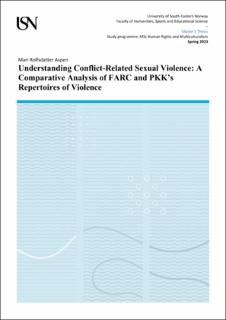| dc.description.abstract | Conflict-related sexual violence (CRSV) is one of the most horrific, least understood, and under researched phenomena concerning modern warfare and armed conflict (Cohen, 2013a, p. 461). Moreover, earlier research focusing on conflict and post-conflict settings have not meaningfully incorporated gender-based violence. With the advancement of women’s human rights, the genocide in Rwanda in 1994, and the conflicts in the former Yugoslavia in the 1990s, CRSV has increasingly gained attention in research and international politics.
In the wake of this increased interest, this thesis main objective is to investigate CRSV through a comparative analysis of the repertoires of two armed groups, based on existing literature. The armed groups in focus are Fuerzas Armadas Revolucionarias Colombianas (FARC) and Partiya Karkeran Kurdistan (PKK). The choice to compare one group that has done an extensive use of sexual violence (FARC), with one that has not employed it (PKK), is in line with the aim of contributing to research on the mechanisms behind CRSV and the reasons for its use and variation in use. Over the last decades, it has become increasingly clear that CRSV varies in form and frequency across different conflicts (Wood, 2006). In this regard, the comparative analysis of the two case studies covers different explanations for the use or non-use of sexual violence as a war strategy. To this extent, the thesis draws on Cohen’s (2013a) theory on the level of group cohesion influencing the level of CRSV, and Wood’s (2009) theory on strong norms and military hierarchy, limiting the use of sexual violence.
The research findings emphasize how forced recruitment mechanisms, leading to lower group cohesion, is a risk factor for high levels of sexual violence. However, these risk factors can be mediated by norms against sexual violence in combination with military training and strong internal military discipline and hierarchy. | |
